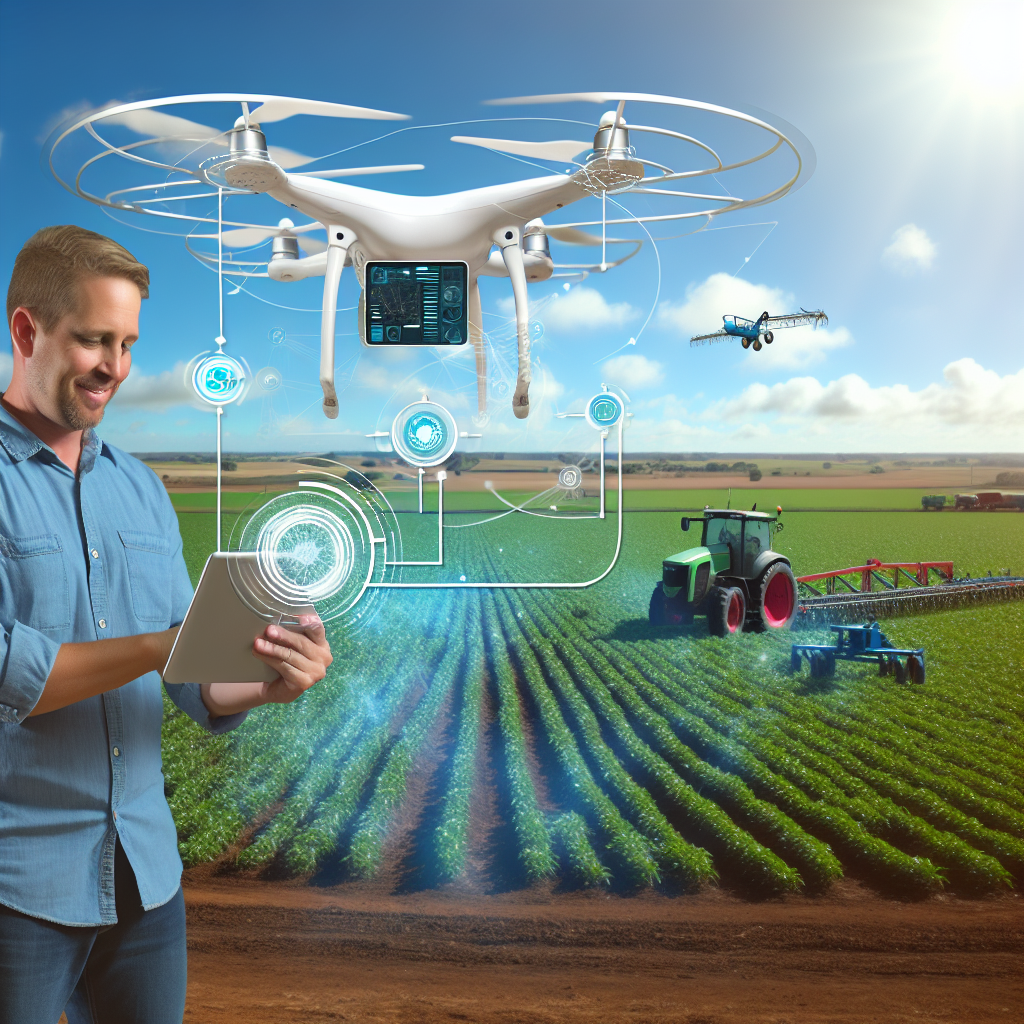Understanding Digital Transformation in Agriculture
Defining Digital Transformation
Digital transformation refers to integrating digital technology into all areas of farming.
This process fundamentally changes how farms operate and deliver value.
It not only enhances efficiency but also enables innovation in agricultural practices.
The Importance of Technology in Farming
Technology plays a critical role in modern farming strategies.
Farmers leverage innovative tools to optimize yields and manage resources.
Moreover, technology helps in reducing waste and enhancing sustainability.
Key Components of Digital Transformation
Several components drive digital transformation in agriculture.
- Data analytics tools provide insights from vast datasets.
- Precision farming techniques enable targeted resource utilization.
- IoT devices facilitate real-time monitoring of crops and livestock.
- Cloud computing solutions enhance collaborative planning and data sharing.
Challenges in Adoption
While the benefits are substantial, challenges persist in adopting digital practices.
Many farmers face initial investment costs related to technology implementation.
Additionally, there is often a lack of technical skills among the workforce.
Furthermore, data security concerns can deter farmers from adopting digital solutions.
Case Studies of Successful Implementation
Various farms have successfully implemented digital transformation strategies.
For example, Green Valley Farms uses drones for crop health monitoring.
Similarly, Sunny Acres employs soil sensors for optimized irrigation practices.
These examples illustrate the substantial impact of digital tools on operational efficiency.
Transform Your Agribusiness
Unlock your farm's potential with expert advice tailored to your needs. Get actionable steps that drive real results.
Get StartedThe Future of Agriculture
The future of farming lies in further integrating digital technologies.
As technology evolves, farmers can expect even greater advancements.
Consequently, the agricultural sector will become more resilient and productive.
Digital transformation promises to revolutionize agriculture for generations to come.
Key Technologies Driving Digital Transformation on Farms
Precision Agriculture
Precision agriculture enhances farm productivity and efficiency.
This technology uses data analysis and IoT devices to optimize farming practices.
Farmers can utilize GPS technology to better manage their fields.
Sensors monitor soil health and moisture levels in real time.
Moreover, drones offer aerial imagery for crop assessment.
Automation in Farming
Automation significantly reduces labor costs on farms.
Robots can perform tasks such as planting, harvesting, and packing.
Automated tractors can navigate fields with minimal human input.
This equipment enhances operational efficiency and precision.
Furthermore, automation allows farmers to manage larger areas effectively.
Data Analytics
Data analytics provides valuable insights into farming operations.
Farmers analyze historical data to predict crop yields and market trends.
These insights inform decision-making and resource allocation.
Using analytics, farmers can identify patterns and optimize productivity.
Continuous data collection improves long-term agricultural strategies.
Supply Chain Management Tools
Effective supply chain management boosts profitability for farmers.
Technology improves transparency and efficiency from farm to table.
Farmers can track products and manage inventory using software solutions.
Real-time tracking enhances accountability throughout the supply chain.
This approach helps reduce waste and ensures timely deliveries.
Showcase Your Farming Business
Publish your professional farming services profile on our blog for a one-time fee of $200 and reach a dedicated audience of farmers and agribusiness owners.
Publish Your ProfileInnovative Crop Management Software
Crop management software streamlines farming operations.
This software assists with planning, scheduling, and monitoring crops.
Farmers can adapt their strategies based on crop performance data.
With constant updates, they stay informed about best practices.
Cloud-based solutions allow for easy access and collaboration among teams.
Smart Irrigation Systems
Smart irrigation systems conserve water and enhance crop growth.
These systems use sensors to determine the right amount of irrigation.
Farmers save water and reduce costs through efficient usage.
Automated systems can adjust irrigation schedules based on weather data.
This technology supports sustainable water management practices.
Steps to Assess Current Farm Operations for Digitization
Evaluate Existing Technology
Begin by creating an inventory of current farm technologies.
Identify tools that support operations, such as tractors and irrigation systems.
Next, assess the software used for managing farm operations.
Evaluate the integration level of these technologies.
Determine if current equipment can support new digital solutions.
Analyze Data Management Practices
Review how data is collected across various farm operations.
Check if data is stored securely and efficiently.
Assess who has access to critical information on the farm.
Identify gaps in data flow that could hinder digitization.
Engage with Farm Employees
Conduct interviews with employees to understand their daily tasks.
Gather feedback on current operational challenges.
Identify areas where technology could enhance efficiency.
Consider employee comfort and familiarity with digital tools.
Understand Customer Needs
Reach out to customers for insight into their expectations.
Analyze how digital tools can improve customer interactions.
Investigate trends that may affect customer preferences.
Ensure that digital strategies align with customer demand.
Benchmark Against Industry Standards
Research digital transformation practices in your industry segment.
Identify successful case studies from other farms.
Compare your operations with those employing advanced technologies.
Evaluate gaps between your practices and industry leaders.
Create a Digitization Roadmap
Based on your assessment, outline a step-by-step plan for digitization.
Prioritize areas for improvement based on urgency and feasibility.
Set clear, measurable objectives for each phase of the plan.
Allocate necessary resources, including budget and personnel.
Schedule regular reviews to track progress and adapt strategies.
See Related Content: Diversification Strategies for Risk Management on Farms
Integrating Precision Farming Technologies
Understanding Precision Farming
Precision farming utilizes technology to monitor and manage field variability.
Farmers employ data-driven approaches to enhance crop yields.
This method optimizes inputs like water, fertilizers, and seeds.
Showcase Your Farming Business
Publish your professional farming services profile on our blog for a one-time fee of $200 and reach a dedicated audience of farmers and agribusiness owners.
Publish Your ProfileOverall, precision farming improves sustainability and efficiency.
Essential Technologies for Precision Farming
Modern farms benefit from several key technologies in precision farming.
GPS technology allows for accurate field mapping.
Drones provide aerial imagery for crop health monitoring.
Soil sensors help manage nutrient levels effectively.
Data analytics platforms interpret vast amounts of agricultural data.
Implementing Precision Farming Strategies
To implement precision farming, farmers should first assess their needs.
Next, they can select the right technologies for their operations.
Training staff on new systems ensures effective usage.
Regularly updating equipment keeps technology current.
Finally, farmers should evaluate the results and adjust strategies accordingly.
Benefits of Precision Farming
Precision farming leads to cost reductions across various operations.
Farmers experience improved crop yields and quality.
This technology also leads to better resource management.
Ultimately, sustainability in farming practices is enhanced.
Case Studies of Successful Integration
Many farms have successfully integrated precision farming technologies.
Green Valley Farm saw a 30% increase in crop yields after adopting soil sensors.
Horizon Farms effectively reduced water usage through smart irrigation systems.
Additionally, Willow Creek Farm reported significant savings in fertilizer costs.
These examples highlight the potential of precision agriculture.
Delve into the Subject: Implementing Organic Farming Practices for Sustainable Agriculture
The Role of Data Analytics in Farm Management
Introduction to Data Analytics
Data analytics plays a crucial role in modern farm management.
This technology enables farmers to make informed decisions.
By analyzing data, farms can optimize their operations efficiently.
Improving Crop Yields
Analytics provides insights into crop performance.
Farmers can identify which crops are most productive.
This knowledge allows for better resource allocation.
Consequently, yields can increase significantly.
Precision Agriculture
Precision agriculture uses data to enhance farming practices.
Farmers can target specific areas for improvement.
This method reduces waste and increases efficiency.
As a result, profitability grows for farmers.
Resource Management
Effective resource management is vital in farming.
Data analytics assists in monitoring water usage and soil health.
Farmers can track inputs and outputs efficiently.
This optimization minimizes costs and environmental impact.
Data-Driven Decisions
Making data-driven decisions leads to better outcomes.
Farmers can assess historical data and current trends.
This analysis empowers them to anticipate issues promptly.
Resilience in farming increases dramatically.
Showcase Your Farming Business
Publish your professional farming services profile on our blog for a one-time fee of $200 and reach a dedicated audience of farmers and agribusiness owners.
Publish Your ProfileMarket Insights
Data analytics also provides vital market insights.
Farmers can analyze consumer preferences and sales trends.
This knowledge helps in predicting demand accurately.
Consequently, farmers can adjust production levels accordingly.
Competitive Advantage
Utilizing analytics gives farmers a competitive edge.
It enables them to respond quickly to market changes.
This flexibility leads to greater market success.
Farmers gain a reputation for being innovative.
Challenges and Considerations
Despite its benefits, data analytics presents challenges.
Farmers may face issues related to data management.
Furthermore, technology adoption can be costly.
Support and training are essential for effective implementation.
Future of Data Analytics in Farming
The future of data analytics in farming is promising.
Emerging technologies continue to enhance data capabilities.
Integration of artificial intelligence will revolutionize agriculture.
This evolution will lead to even more efficient practices.
Discover More: Streamlining Supply Chains To Lower Agribusiness Costs

Developing a Digital Roadmap for Farmers
Assessing Current Capabilities
Begin by evaluating the existing technological infrastructure on the farm.
Identify the types of equipment and software currently in use.
Next, assess employee skill levels regarding digital tools.
Create a list of strengths and weaknesses within the current system.
Defining Specific Goals
Establish clear objectives for digital transformation efforts.
Consider what you want to achieve with technology adoption.
For example, improve yield efficiency or enhance data management.
Document these goals to serve as guiding principles.
Researching Technologies and Solutions
Investigate emerging technologies relevant to modern farming.
Explore precision agriculture tools for optimal resource management.
Evaluate options for farm management software to streamline processes.
Additionally, examine IoT devices that enhance real-time monitoring.
Building a Digital Strategy
Draft a comprehensive digital strategy based on initial assessments.
Include timelines and milestones to track progress.
Engage stakeholders to gather input and build consensus.
Ensure that your plan aligns with overall farm management goals.
Implementing Training Programs
Develop training sessions for staff to increase digital literacy.
Choose hands-on workshops that focus on specific tools.
Encourage continuous learning to keep up with technology trends.
Create a culture that embraces change and innovation.
Monitoring and Evaluating Progress
Establish metrics to measure the success of digital initiatives.
Regularly review and refine strategies based on these metrics.
Gather feedback from employees and adjust training programs accordingly.
Showcase Your Farming Business
Publish your professional farming services profile on our blog for a one-time fee of $200 and reach a dedicated audience of farmers and agribusiness owners.
Publish Your ProfileStay flexible to accommodate new technologies as they emerge.
Discover More: Renewable Energy Solutions for Eco-Friendly Agribusiness
Training and Upskilling Workforce for a Digital Future
The Importance of Workforce Development
In the rapidly evolving agricultural sector, workforce development is crucial.
Farmers face challenges from emerging technologies and digital solutions.
These developments demand new skills from the workforce.
Ongoing education helps employees adapt to new tools.
Additionally, skilled workers can improve farm productivity and efficiency.
Assessing Current Skills and Needs
Begin by assessing the current skill levels of your workforce.
Identify gaps in knowledge related to digital practices.
Consider the specific technologies your farm plans to implement.
Gather feedback from employees on their training needs.
This approach encourages employee engagement from the start.
Implementing Training Programs
Design training programs tailored to the identified needs.
Utilize various formats, such as online courses and hands-on workshops.
Invite industry experts to provide insights and mentorship.
Focus on both technical skills and soft skills, such as problem-solving.
Incorporate practical applications to reinforce learning.
Promoting a Culture of Continuous Learning
Encourage a culture that values continuous learning and improvement.
Recognize and reward employees who pursue further education.
Provide resources for self-directed learning opportunities.
Implement regular workshops to share the latest advancements.
Leverage e-learning platforms for ongoing access to training materials.
Measuring Success
Establish metrics to evaluate the effectiveness of training initiatives.
Track employee performance before and after training interventions.
Gather feedback from participants to refine future programs.
Set specific goals to measure productivity improvements over time.
Adjust strategies based on the outcomes and employee feedback.
Evaluating the ROI of Digital Investments in Agriculture
Understanding ROI in Agriculture
Return on Investment (ROI) measures the profitability of investments.
It evaluates the financial returns generated by farming technologies.
Understanding ROI helps farmers make informed decisions.
Furthermore, it allows for the assessment of various digital tools.
Key Digital Investments in Agriculture
Several digital tools enhance agricultural productivity and efficiency.
Farmers can invest in precision agriculture technologies.
These technologies include drones, sensors, and smart irrigation systems.
Additionally, farm management software streamlines operations.
Investing in data analytics improves decision-making processes.
Moreover, blockchain technology ensures supply chain transparency.
Measuring Financial Returns
To measure ROI, consider both costs and benefits of investments.
Calculate initial investment costs, such as purchasing equipment.
Next, assess operational costs including maintenance and training.
Showcase Your Farming Business
Publish your professional farming services profile on our blog for a one-time fee of $200 and reach a dedicated audience of farmers and agribusiness owners.
Publish Your ProfileOn the benefits side, evaluate increased yields and reduced waste.
Additionally, consider labor savings from automation.
Finally, calculate overall revenue gains from these improvements.
Case Studies of Successful Digital Investments
Examining success stories provides valuable insights.
For instance, Greenfields Farms implemented precision agriculture tools.
This investment led to a 20% increase in crop yields.
Another example is Sunnyvale Produce, which adopted farm management software.
This led to a 30% reduction in operational costs.
Such examples show how digital investments can drive profitability.
Challenges in Evaluating ROI
Evaluating ROI in agriculture is not without challenges.
For instance, fluctuating market conditions can impact revenues.
Additionally, the long payback periods of some technologies pose risks.
Moreover, measuring qualitative benefits is often difficult.
Farmers must consider intangible aspects like improved decision-making.
Strategies for Maximizing ROI
To enhance ROI, farmers should adopt a phased approach to technology implementation.
This allows for gradual integration and assessment of new tools.
Conducting pilot programs can provide critical insights before full-scale investment.
Furthermore, continuous training for farm staff is essential.
They should be equipped to use new technologies effectively.
Finally, monitoring and adapting strategies based on performance data is crucial.
Additional Resources
2026 Strategic Plan – U.S. Department of Commerce 2022
U.S. Agriculture Innovation Strategy Directional Vision for Research




